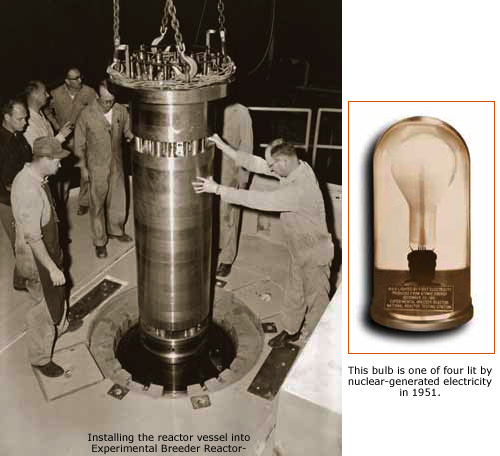1950-1970: First generation of reactors (50 – 500 MWe)
The first generation reactors were in the 1950s and 1960s the precursors of today big commercial reactors producing electricity, especially in the U.S., the former Soviet Union, France and the United Kingdom. The development of the civilian use of the atom owes much to U.S. President Dwight Eisenhower who, on December 8, 1953, during a famous address to the General Assembly of the United Nations, launched the Atoms for Peace initiative in response to the escalating nuclear arms race between the U.S. and the Soviet Union.

1951: Experimental Breeder Reactor
On December 20, 1951 at 1:50 pm, the very first amount of nuclear electricity is provided by a turbo-generator and lit four light bulbs, whose brilliant light marks the birth of nuclear energy. The next day, the experiment is repeated and this time the entire building housing the experiment illuminated. As its name suggests, the first Experimental Breeder Reactor (EBR) was intended to do research on fast breeder reactors, of which it demonstrated the possibility before stopping activities in 1964.
@ Idaho National Laboratory
The powers of these precursors seem modest compared with those of their faraway successors of today. In 1951, the EBR-1 prototype in the U.S. was producing just enough electricity to lit four light bulbs. In 1954 in the former Soviet Union, the electric power of the world’s first nuclear power plant producing electricity in Obninsk, dubbed « Atom Mirny » did not exceed 5 Megawatts (MW). This reactor, the precursor of the unfortunate Chernobyl RBMK reactors, was cooled by water and moderated using graphite. It ran until 2002. The year 1954 saw also the launching of the world’s first nuclear-powered submarine, the USS Nautilus (a pressurized water reactor of 10 MWth).
At the time, most of these reactors used natural uranium as fuel, the use of enrichment being not available for civilian purposes. Such was the case of Canadian CANDU reactors whose heavy water serves both to moderate neutrons and dissipate the heat. This was also the case for reactors using graphite as a moderator and pressurized CO2 as a cooler. The French graphite-gas reactors (UNGG) and the UK Magnox reactors were also part of this category. The first Magnox (50 MW) was opened at Calder Hall in 1956 and the first French GCR of 70 MWe at Chinon in 1963. The RBMK (100 MWe) prototype using slightly enriched uranium dates from 1963.
Apart from CANDU reactors, few of these reactors are still in service. In the EU there remained only two UK MAGNOX of the eleven original, that were shut down in 2010.

1957: inauguration of the Calder Hall reactor
On 17 October 1956, the young Queen Elizabeth inaugurated the first of four Calder Hall Magnox reactors at Windscale (Sellafield), which functioned until 2003. These Magnox reactors should not be confused with the Windscale atomic piles, whose purpose was to produce plutonium for military purposes. One of these atomic piles was in 1957 the place of the Windscale accident with limited consequences and whose analysis prevented further accidents of the same type..
@ Hulton Archive / Getty Images
Other first-generation reactors derived from the onboard reactors of submarines were the precursors of the pressurized (PWR) or boiling (BWR) water reactors. The use of ordinary water required enriched uranium. It was again in the United States that were built the first pressurized water reactor located near Westinghouse (1957, Shippingport, 60 MWe) and the first boiling water reactor (General Electric 1959, Dresden).
The 1950-1970 period was characterized by an explosion of concepts. This period also saw the first prototypes of fast breeder sodium-cooled reactors : Enrico Fermi in 1963 (USA), Rhapsody in 1967 (France), BOR-60 in 1968 (Soviet Union), and later on that of Joyo in 1978 (Japan). The great advantage of these breeder reactors is their ability to generate more fissile material than they consume. Already in the 50’s and 60’s,nuclear fuel supply and management of the fuel cycle were perceived as major concerns for a sustainable development. This pioneersing work on fast reactors paved half a century ahead the way to the present studies on the future Generation IV reactors.
NEXT : Generation II reactors
Other articles on the subject « Nuclear Reactors »
Reactor Families
A variety of designs : Natural uranium or enriched uranium as fuel There are several industrial t[...]
World nuclear reactors
A development that takes place today in Asia At the beginning of 2014 the number of reactors in o[...]
RBMK reactors
Soviet-era reactors at Chernobyl Cold War and the Iron Curtain led after 1947 to the development [...]
Generation II Reactors
1970-2009: the rise of nuclear energy About 85% of electricity produced worldwide by nuclear powe[...]
PWR Reactors
The most widespread type of reactor … Pressurised water reactors (PWR) are by far the most [...]
PWR Operation
High pressure water to evacuate heat and slow down neutrons The reactor core is the source of ene[...]
Boiling Water Reactors
BWR or Boiling Water Reactors Boiling water reactors or BWR are in operation in the United States[...]
Candu reactors
Canadian reactors using natural uranium and heavy water CANDU is a nuclear reactor brand develope[...]
Nuclear Propulsion
On-board reactors for submarines and aircraft carriers In addition to conventional land-based pow[...]